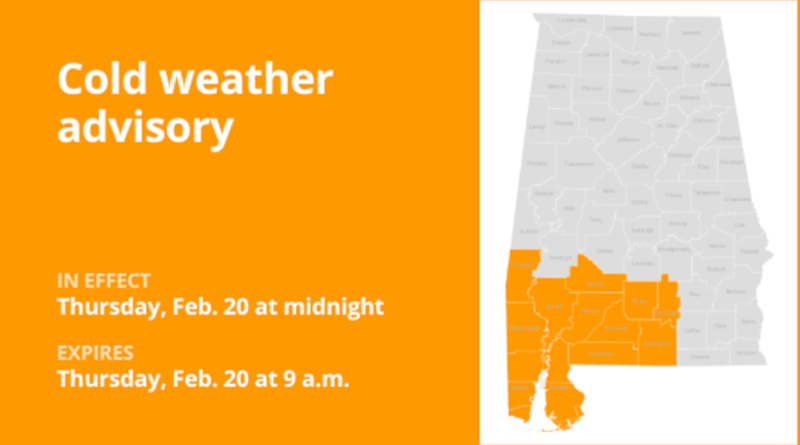Cold weather advisory for South Alabama for Thursday
On Wednesday at 2:15 a.m. a cold weather advisory was issued by the National Weather Service valid for Thursday between midnight and 9 a.m. for Choctaw, Washington, Clarke, Wilcox, Monroe, Conecuh, Butler, Crenshaw, Escambia, Covington, Mobile and Baldwin counties.
The weather service adds, “Very cold wind chills as low as 10 above expected.”
“Frostbite and hypothermia will occur if unprotected skin is exposed to these temperatures. An extended period of subfreezing temperatures could cause pipes to burst,” adds the weather service. “Use caution while traveling outside. Wear appropriate clothing, a hat, and gloves. Keep pets indoors as much as possible. To prevent freezing and possible bursting of pipes they should be wrapped, drained, or allowed to drip slowly.”

Understanding cold weather alerts
Cold weather advisory: Be Aware. A cold weather advisory is issued when seasonably cold air temperatures or wind chill values, but not extremely cold values, are expected or occurring. Be sure you and your loved ones dress appropriately and cover exposed skin when venturing outdoors.
Extreme cold warning: Take Action! An extreme cold warning is issued when dangerously cold air temperatures or wind chill values are expected or occurring. If you are in an area with an extreme cold warning, avoid going outside. If you have to go outside, dress in layers, cover exposed skin, and make sure at least one other person knows your whereabouts. Update them when you arrive safely at your destination.
Extreme cold watch: Be Prepared. An extreme cold watch is issued when dangerously cold air temperatures or wind chill values are possible. As with a warning, adjust your plans to avoid being outside during the coldest parts of the day. Make sure your car has at least half a tank of gas, and update your winter survival kit.
Advance Local Weather Alerts is a service provided by United Robots, which uses machine learning to compile the latest data from the National Weather Service.

